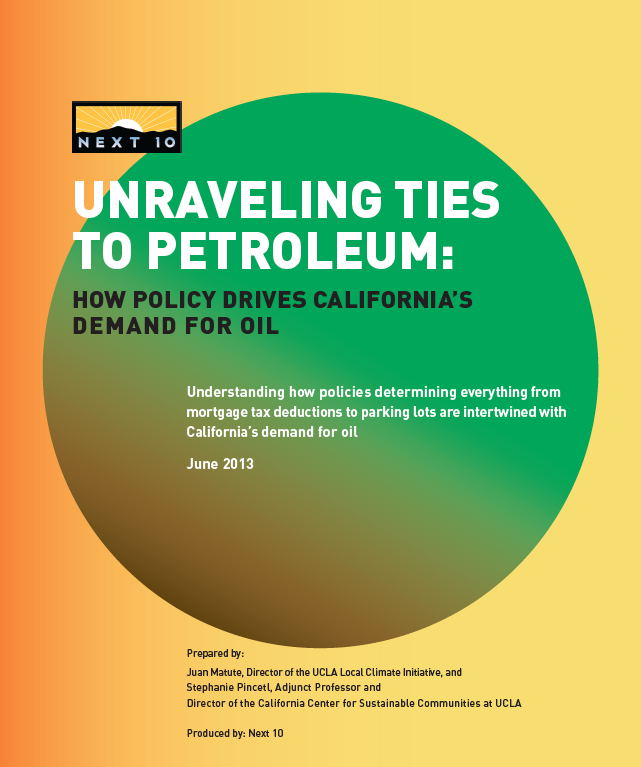Publications
Unraveling Ties to Petroleum: How Policy Drives California's Demand for Oil
A new study highlights the connection between seemingly unconnected policies and the Golden Stateʼs demand for oil.
California policies that have seemingly little to no connection to petroleum use actually provide incentives that drive demand for oil use artificially high in the state. Fifteen such policies are identified in Next 10's new report authored by UCLA experts (see Additional Resources tab for PDFs of each policy).
Petroleum accounts for the greatest total share of Californiaʼs energy demand, supplying 43.7 percent of our energy needs. The report consists of 15 separate policy briefs that focus on policies affecting Californiaʼs transportation sector. The transportation sector accounts for nearly 40 percent of the stateʼs energy consumption.
Policies that govern how parking spaces are created and subsidized, how road space is allocated, how local governments fund infrastructure needed for infill development, and how automobile insurers charge premiums were found to be the most impactful in terms of driving petroleum demand in California. By addressing these policies, California could reduce future petroleum use by at least 25 percent.
- Some of the policy choices conceal the true cost of providing automobile infrastructure.
- For instance, minimum parking requirements create implicit user-subsidies when the cost of parking is bundled in the cost of other goods or services.
- In addition, employer parking subsidies hide parking costs from employees without always offering non-drivers a similar subsidy.
- Other measures unintentionally perpetuate private passenger vehicle use—and associated petroleum consumption—while impeding the scope or quality of alternatives.
- For example, the methods that transportation departments employ to assess the performance of the transportation system continue to influence most traffic engineering decisions in favor of single-occupant automobiles.
- Furthermore, the conventional approach to adding High-Occupancy Vehicle (HOV) lanes through construction, rather than conversion of existing lanes, delays the implementation of HOV networks.
- Among policy developments that help reduce California’s petroleum dependence, the introduction of new services allowing travelers to share rides and even share cars is particularly promising.
- Behind both of these programs is the relatively new idea of transportation as a service, allowing consumers the choice of foregoing the purchase, maintenance, and storage of a private vehicle.
- The savings for the state could be huge: filling just ten percent of the excess capacity of private passenger vehicles currently operating in California could lead to an 18 percent reduction in motor vehicle fuel use. Approximately 69 percent of passenger vehicle seat-miles currently go unfilled.
- Nonetheless, current regulatory and market barriers threaten the growth of new, Internet-enabled peer-to-peer ridesharing services.
- Some measures combine to increase California’s reliance on oil.
- For instance, minimum parking requirements increase the number of parking spaces per acre in dense areas, with more parking spaces per acre leading to more traffic congestion.
- Policymakers then seek to mitigate this problem with automobile-based transportation system performance standards. These standards often seek to remedy congestion through roadway widening, but end up perpetuating traffic congestion in corridors where the public right-of-way is finite.
- Furthermore, these policies inhibit a shift toward transit use to increase the number of people traveling through congested corridors – even in high-quality transit areas.
- In some cases, policies distort land use, compelling drivers to make longer trips and diluting the attractiveness of alternative modes.
- The home mortgage interest deduction may contribute to larger homes and larger lot sizes.
- Local planners possess a greater range of financing mechanisms for public infrastructure improvements needed in greenfield areas than in infill areas, which have more complex financing needs.
- The location of state enterprise zones far from population centers may force workers to accept longer commutes.
- The conventional approach to parking policy—obliging each parcel to provide a minimum amount of parking—leads to large land areas devoted to parking, changing neighborhoods and transportation options.
